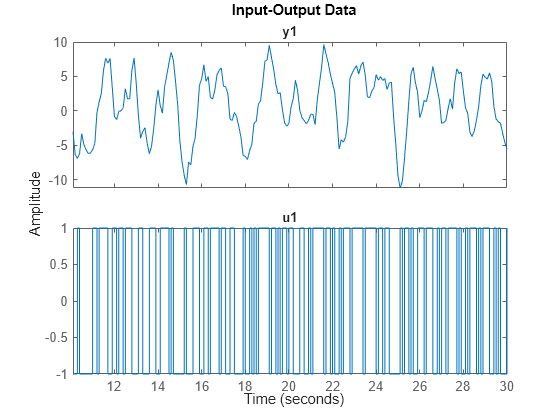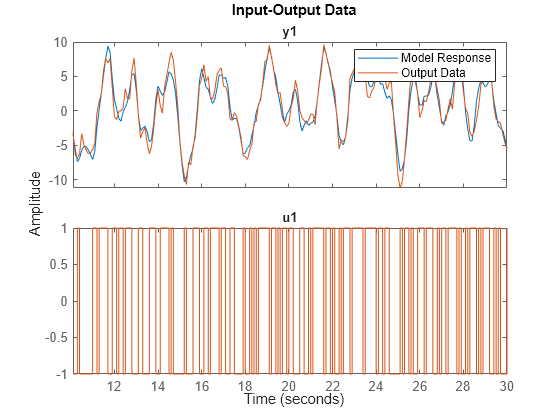simOptions
Option set for sim
Description
Examples
opt = simOptions;
Create an option set for sim specifying the following options.
Zero initial conditions
Input offset of 5 for the second input of a two-input model
opt = simOptions('InitialCondition','z','InputOffset',[0; 5]);
Create noise data for a simulation with 500 input data samples and two outputs.
noiseData = randn(500,2);
Create a default option set.
opt = simOptions;
Modify the option set to add the noise data.
opt.AddNoise = true; opt.NoiseData = noiseData;
Use historical input-output data as a proxy for initial conditions when simulating your model.
Load a two-input, one-output data set.
load iddata7 z7
Identify a fifth-order state-space model using the data.
sys = n4sid(z7, 5);
Split the data set into two parts.
zA = z7(1:15); zB = z7(16:end);
Simulate the model using the input signal in zB.
uSim = zB;
Simulation requires initial conditions. The signal values in zA are the historical data, that is, they are the input and output values for the time immediately preceding data in zB. Use zA as a proxy for the required initial conditions.
IO = struct('Input',zA.InputData,'Output',zA.OutputData); opt = simOptions('InitialCondition',IO);
Simulate the model.
ysim = sim(sys,uSim,opt);
To understand how the past data is mapped to the initial states of the model, see Understand Use of Historical Data for Model Simulation.
Load and plot the data.
load iddata1ic z1i plot(z1i)

Examine the initial value of the output data y(1).
ystart = z1i.y(1)
ystart = -3.0491
The measured output does not start at 0.
Estimate a second-order transfer function sys and return the estimated initial condition ic.
[sys,ic] = tfest(z1i,2,1); ic
ic =
initialCondition with properties:
A: [2×2 double]
X0: [2×1 double]
C: [0.2957 5.2441]
Ts: 0
ic is an initialCondition object that encapsulates the free response of sys, in state-space form, to the initial state vector in X0.
Simulate sys using the estimation data but without incorporating the initial conditions. Plot the simulated output with the measured output.
y_no_ic = sim(sys,z1i); plot(y_no_ic,z1i) legend('Model Response','Output Data')

The measured and simulated outputs do not agree at the beginning of the simulation.
Incorporate the initial condition into the simOptions option set.
opt = simOptions('InitialCondition',ic); y_ic = sim(sys,z1i,opt); plot(y_ic,z1i) legend('Model Response','Output Data')

The simulation combines the model response to the input signal with the free response to the initial condition. The measured and simulated outputs now have better agreement at the beginning of the simulation. This initial condition is valid only for the estimation data z1i.
Name-Value Arguments
Specify optional pairs of arguments as
Name1=Value1,...,NameN=ValueN, where Name is
the argument name and Value is the corresponding value.
Name-value arguments must appear after other arguments, but the order of the
pairs does not matter.
Before R2021a, use commas to separate each name and value, and enclose
Name in quotes.
Example: 'AddNoise',true','InputOffset',[5;0] adds
default Gaussian white noise to the response model and specifies an
input offset of 5 for the first of two model inputs.
Simulation initial conditions, specified as one of the following:
'z'— Zero initial conditions.Numerical column vector of initial states with length equal to the model order.
For multiexperiment data, specify a matrix with Ne columns, where Ne is the number of experiments, to configure the initial conditions separately for each experiment. Otherwise, use a column vector to specify the same initial conditions for all experiments.
Use this option for state-space models (
idssandidgrey) only.initialConditionobject —initialConditionobject that represents a model of the free response of the system to initial conditions. For multiexperiment data, specify a 1-by-Ne array of objects, where Ne is the number of experiments.Use this option for linear models only. For an example, see Obtain and Apply Estimated Initial Conditions.
Structure with the following fields, which contain the historical input and output values for a time interval immediately before the start time of the data used in the simulation:
Field Description InputInput history, specified as a matrix with Nu columns, where Nu is the number of input channels. For time-series models, use []. The number of rows must be greater than or equal to the model order.OutputOutput history, specified as a matrix with Ny columns, where Ny is the number of output channels. The number of rows must be greater than or equal to the model order. For an example, see Use Historical Data to Specify Initial Conditions for Model Simulation.
For multiexperiment data, configure the initial conditions separately for each experiment by specifying
InitialConditionas a structure array with Ne elements. To specify the same initial conditions for all experiments, use a single structure.The software uses
data2stateto map the historical data to states. If your model is notidss,idgrey,idnlgrey, oridnlarx, the software first converts the model to its state-space representation and then maps the data to states. If conversion of your model toidssis not possible, the estimated states are returned empty.'model'— Use this option foridnlgreymodels only. The software sets the initial states to the values specified in thesys.InitialStatesproperty of the modelsys.[]— Corresponds to zero initial conditions for all models exceptidnlgrey. Foridnlgreymodels, the software treats[]as'model'and specifies the initial states assys.InitialStates.
Covariance of initial states vector, specified as one of the following:
Positive definite matrix of size Nx-by-Nx, where Nx is the model order.
For multiexperiment data, specify as an Nx-by-Nx-by-Ne matrix, where Ne is the number of experiments.
[]— No uncertainty in the initial states.
Use this option only for state-space models (idss and idgrey)
when 'InitialCondition' is specified as a column
vector. Use this option to account for initial condition uncertainty
when computing the standard deviation of the simulated response of
a model.
Input-channel intersample behavior for transformations between discrete time and continuous time, specified as 'auto', 'zoh','foh', or 'bl'.
The definitions of the three behavior values are as follows:
'zoh'— Zero-order hold maintains a piecewise-constant input signal between samples.'foh'— First-order hold maintains a piecewise-linear input signal between samples.'bl'— Band-limited behavior specifies that the continuous-time input signal has zero power above the Nyquist frequency.
iddata objects have a similar property,
data.InterSample, that contains the same behavior value options.
When the InputInterSample value is 'auto' and
the estimation data is in an iddata object data, the
software uses the data.InterSample value. When the estimation data
is instead contained in a timetable or a matrix pair, with the 'auto'
option, the software uses 'zoh'.
The software applies the same option value to all channels and all experiments.
Input signal offset, specified as a column vector of length Nu.
Use [] if there are no input offsets. Each element
of InputOffset is subtracted from the corresponding
input data before the input is used to simulate the model.
For multiexperiment data, specify InputOffset as:
An Nu-by-Ne matrix to set offsets separately for each experiment.
A column vector of length Nu to apply the same offset for all experiments.
Output signal offset, specified as a column vector of length Ny.
Use [] if there are no output offsets. Each element
of OutputOffset is added to the corresponding
simulated output response of the model.
For multiexperiment data, specify OutputOffset as:
An Ny-by-Ne matrix to set offsets separately for each experiment.
A column vector of length Ny to apply the same offset for all experiments.
Noise addition toggle, specified as a logical value indicating whether to add noise to the response model.
Noise signal data specified as one of the following:
[]— Default Gaussian white noise.Matrix with Ns rows and Ny columns, where Ns is the number of input data samples, and Ny is the number of outputs. Each matrix entry is scaled according to
NoiseVarianceproperty of the simulated model and added to the corresponding output data point. To setNoiseDataat a level that is consistent with the model, use white noise with zero mean and a unit covariance matrix.Cell array of Ne matrices, where Ne is the number of experiments for multiexperiment data. Use a cell array to set the
NoiseDataseparately for each experiment, otherwise set the same noise signal for all experiments using a matrix.
NoiseData is the noise signal, e(t),
for the model
Here,G is the transfer function from the input, u(t), to the output, y(t), and H is the noise transfer function.
NoiseData is used for simulation only when AddNoise is
true.
Times at which the output is calculated, specified as one of the following:
Empty matrix,
[]. This is the default option, in which output times are not specified. For systems with inputs, the output sample times are chosen to be the same as those of the input signals. For autonomous systems (that is, systems with no inputs) a non-empty value forOutputTimesmust be specified, otherwise, an error is generated during simulation.Time span [tMin, tMax], where tMin and tMax are expressed in the time units of the model.
Time vector. A column vector of doubles. For models with inputs, the time vector must be contained within the time span of the simulation inputs (that is entries cannot be outside the time range of the input signals). For discrete-time models, the time interval must match the model sample time.
Cell array. This option is used for multi-experiment simulations. Each element of the cell contains an array of time spans or time vectors, one array for each data experiment.
Output Arguments
Option set for sim command, returned as
a simOptions option set.
Version History
Introduced in R2012aiddata objects contain an InterSample property that
describes the behavior of the signal between sample points. The
InputInterSample option implements a version of that property in
simOptions so that intersample behavior can be specified also when
estimation data is stored in timetables or matrices.
See Also
MATLAB Command
You clicked a link that corresponds to this MATLAB command:
Run the command by entering it in the MATLAB Command Window. Web browsers do not support MATLAB commands.
选择网站
选择网站以获取翻译的可用内容,以及查看当地活动和优惠。根据您的位置,我们建议您选择:。
您也可以从以下列表中选择网站:
如何获得最佳网站性能
选择中国网站(中文或英文)以获得最佳网站性能。其他 MathWorks 国家/地区网站并未针对您所在位置的访问进行优化。
美洲
- América Latina (Español)
- Canada (English)
- United States (English)
欧洲
- Belgium (English)
- Denmark (English)
- Deutschland (Deutsch)
- España (Español)
- Finland (English)
- France (Français)
- Ireland (English)
- Italia (Italiano)
- Luxembourg (English)
- Netherlands (English)
- Norway (English)
- Österreich (Deutsch)
- Portugal (English)
- Sweden (English)
- Switzerland
- United Kingdom (English)